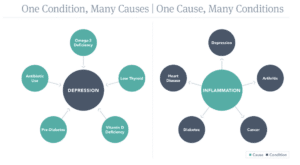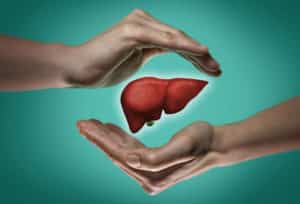When you’re dragging your sorry butt out of bed, and your kid is talking, but geez it sounds like he’s SHOUTING, and you’re wondering if you could please just get a caffeinated IV infusion, it’s time to sort things out. This is the WORST, and there are steps you can take to get some relief in the morning.
FIRST, make sure you’ve downloaded my Wired and Tired Rescue Guide:
That is where you’ll find 5 Remedies you can use right away to boost energy and bust brain fog.
NOW, watch this video or read the TRANSCRIPT below, and learn 3 areas that need to be addressed to kick those crappy mornings to the curb!
Make sure you’re getting my e-mails, because I’ll be sending you more in depth information on how to address each of these steps. These are three BIG steps, which each involve many small steps with lots of tips to sort out. I’ve got your back sister, so stay tuned, and I’ll be bringing you all that info 🙂
In this video:
- 0:28: Step 1 for boosting energy & busting brain fog with three tips for Balancing Blood Sugar
- 5:53: Step 2 with three tips for Optimizing Digestion
- 10:41 Step 3 with three tips for Prioritizing Sleep
What are the things that have improved your digestion? Or made your sleep better? Share your thoughts, tips, and ideas below!
TRANSCRIPT OF THE VIDEO:
Hello, ladies. Today I’m gonna talk about three steps to boosting energy and busting brain fog. Today I’m gonna introduce them, and I’m gonna give you a few smaller steps you can take towards these three big categories.
So the first one is to balance blood sugar. This is a pretty big topic with the standard American diet, because we have an abundance of carbohydrate … high carbohydrate and processed foods that our bodies are really not designed to consume, that, you know, have led to very high rates of diabetes, obesity and blood sugar imbalance.
The basics of what I start with, with my clients, in balancing blood sugar, is to make sure that for breakfast we are eating protein and healthy fat. Protein would be something like eggs, or a naturally raised meat, that occasionally maybe we use something like a really good quality protein powder. I really try to focus the most on whole foods.
So a healthy protein and a healthy fat. The healthy fat could be eggs, have healthy fat. We could have a naturally raised bacon, which has healthy fat, we could have avocado, we could have nuts and seeds. If you are further along in your journey, and you intermittent fast where you don’t eat a full meal till later, but you do include a coffee or a tea with a little bit of healthy fat in it, then an MCT oil would be an option or a grass fed butter.
So there’s a lot of options on healthy protein and healthy fat, and this is something I go more in depth on, and I will on future videos and articles. But start your morning out, and make sure you’re getting protein and healthy fat. I just like to add things in before I start removing things, because nobody likes it when they sit down with me, and I start talking about removing, or avoiding, or restricting. None of that feels good, so we just start by adding in good stuff, and eventually the other things get displaced. So we’ll talk about what things we swap out, but start out just with a good breakfast with protein and healthy fat.
If you are intermittent fasting, and you don’t eat breakfast, that is fine, and just make sure that you … when you do eat your first meal of the day, that is has healthy protein and healthy fat. Tip number two is really on the same topic, do this at each meal. So every time you eat, make sure you’re getting healthy fat, healthy protein, and then I’m gonna add in non-starchy vegetables. So make sure we’re getting vegetables as well.
So that’s tip number two, is take what we talked about doing for the first meal of the day, whether that be breakfast, or midday, or later in the day, and then do that at every meal and add in non-starchy vegetables to those meals. Non-starchy vegetables at breakfast is important too, but when I’m working with people, I like to just introduce one step at a time, and eventually we get there. Then it’s not overwhelming and we don’t get stressed out in the process.
Tip number three is to include complex carbohydrates from plant foods at your meals, and swap that for any grain or refined grain food products that you’re eating. So what those refined grain or grain products would be, include breads, and any types of breads like waffles, pizza, pancakes. You know, any type of bread, croissants, cakes, cookies, all that kind of thing. It also includes pastas, so any kind of pasta like lasagna, spaghetti, linguini, anything like that. It also includes rice, and quinoa, and buckwheat, and things like that.
Now, caveat, it is winter, and there’s people that need more carbohydrates in your diet. I’m gonna do a lot more on this, because it really depends on hormones, and are you pregnant? Are you breastfeeding? Are you insulin-resistant? Do you have blood sugar issues? This is gonna make a huge difference as to how many carbs you need. So, I don’t like saying anything’s good or bad, and that, you know, I’m never gonna make blanket recommendations.
This is just generally speaking to the refined grain foods, I would definitely take a look at those, the breads, the pastas, things like that, take those out. If you know right now that you need some complex carbohydrates, some grains, like quinoa or buckwheat, that would be more complex, keep those in, that’s fine. But just start to take a look at the carb amount that you’re eating through the day, if that’s the point where you’re at, and then you can start to optimize that for what you need on a daily basis.
So, what those plant foods would be that you’re putting in, are sweet potatoes, and squashes, winter squashes are great right now. They can be really comforting, and grounding and warming, and give you some of the carbs that you need in the day.
So in general, you’re just putting in more of those complex carbohydrates for the simple carbohydrates, or the more refined grain foods, like the breads and the pastas, and the pizzas and the cookies, and the cakes. So just start with that. As I said, this is a huge topic, and I’m gonna put out a whole video on this, and a lot more content to come on understanding carbohydrates, understanding what kinds or amounts might be right for you based on different conditions, and issues, and lifestyle approaches, as well as where you are in your life cycle. So stay tuned for that.
The second step to boosting energy and busting brain fog is to optimize digestion. This is, again, a huge subject, and one that I love very much, so I will be putting out lots more content on this. But to get you started, here’s three tips to optimize digestion. The first is to use apple cider vinegar daily for a while, and see what that does for you. The way to do this, often times my clients like doing it first thing in the morning. You can add a tablespoon of raw, unfiltered apple cider vinegar to purified or filtered water, and it’s fine if you wanna put it in 6 oz.
A lot of times I suggest, especially in winter time, warming up the water, or at least having it room temperature. But warm water can be great with that one to two tablespoons of raw, unfiltered apple cider vinegar. If you need to add a little organic lemon juice, or a little bit of raw honey, that can help make it a bit more palatable as well. It can be wonderful for digestion, it supports skin health. It’s actually good for the first step that we were talking about, balancing blood sugar. Apple cider vinegar can support appetite and [inaudible 00:07:05], and blood sugar balance.
So, give that one a try, see what it does for you. I have awesome feedback often on apple cider vinegar. If you have some other issues going on with your digestion, such as [inaudible 00:07:20] bacterial overgrowth, or some dysbiosis that’s causing you to be histamine intolerant. Or maybe you have some other issues leading to histamine intolerance, then this may be problematic for you. I’m not gonna go specifically in depth, because we could spend, you know, hours talking about some of these other problems, and I will be putting out content on those in the future.
So this is just a general recommendation that can be great for a lot of people for digestion. But know that if it bothers you, if you have a stomach ulcer, or you have some damage from an issue like celiac disease, or something else that’s been going on, this may not be the right approach for you right now, and that’s okay. But for a lot of you that are feeling okay with your digestion, or feel that you just need a little extra support, it can stimulate enzyme and acid production in the stomach, and help with your digestion, and support all those other things I mentioned as well. So give that one a try.
The second tip is to eat fermented foods, or foods that have healthy bacteria, otherwise known as probiotics. So this could be a cultured yogurt, I would suggest one that doesn’t have a bunch of sugar added, so a plain yogurt. You can always add a little bit of raw honey, or stevia, or some fruit to it, if you’d like to flavor it up at bit. So, that’s sorta the most common thing people think of is yogurt, there’s also kefir, and can use that. Fermented vegetables, like kimchi, sour kraut, pickles. Bubbies is a brand that is fermented.
What you wanna look for on the label, is that there’s sea salt and not vinegar. If there’s vinegar, then it is not cultured or fermented, and you won’t get that healthy bacteria. Other cultured or fermented food options include kombucha, that’s become very popular. It can be a great alternative to to soda or other sweet drinks, or alcoholic beverages. So give that a try if you haven’t yet.
Some of them do have a little more sugar, some have less sugar. So again, with the balancing blood sugar, and where you’re at with that, keep an eye on the sugar amount in those. But they can be a really, really, great option, and especially if you’re consuming any of those other things, it’s a great alternative.
The third tip for optimizing digestion is to eat mindfully. I just did a blog, a vlog, post on this recently, so I’ll put that link below. Go back and watch that, if you haven’t yet. The idea here is that you are relaxed while you’re eating, and that’s gonna be really important for digestion. If you have crazy mornings getting kids off to school, just see if you can find a different time to eat, if you need to eat when you get to work, if that’s possible.
Not perfection, right? Especially when you have kids, and you’re running around, just do the best that you can. If that means that you’re calmer when you’re starting your day at work, and checking your email, then you are when you’re at home trying to get kids fed and coats on, and all that stuff, and out the door, then great. If you have to eat while you’re checking your email, that’s better than the alternative, where you’re … can’t even sit down and take a deep breath. Just try to find ways to relax while you’re eating, and as I mentioned, check out that other video for some other ideas on mindful eating.
Our third step is to prioritize sleep. This may seem obvious, I know, but I have to hear it over and over, so I’m gonna keep telling you over and over, in hopes that it continues to help you support your sleep and your energy. Tip number one is to stop eating two hours before you go to bed. This is also gonna support your blood sugar, and it will support optimal digestion as well.
If you are eating right before bed, go back to what I said about balancing blood sugar, and have that type of meal two hours or more before you go to bed. That will also help your digestion from waking you up, because you’re still trying to digest right after eating, as you’re also trying to fall asleep.
Tip number two, is to stop using technology, or any sort of screens two hours before you go to bed as well. Phones, computer, tablets, anything like that. I know you may have a little bit of that to do in the evening, and I get it, but see if you can do that first. So, for example, what I will do is get my kids to bed, and as soon as they’re in bed, if there’s anything I have to do on my phone, or an email I need to send, I will get that out of the way first. Then I’ll move onto activities that might be more active, but they don’t involve technology, like washing the dishes, sweeping the floor, cleaning up any toys or whatever, you know, getting backpacks ready for the next day.
Then I’ll move into the most relaxing things like maybe taking a shower, getting myself ready for bed. So see if you can organize your night, so that you’re slowly moving towards the more relaxing things before you go to bed. Then tip number three is to take five minutes or more to do something relaxing right before you fall asleep, and ideally, some sort of mindfulness practice.
Yeah, I really like using Insight Timer. Here’s one breaking the rule of using your technology, is if you are going to use something very specifically to be a guided meditation, and I have a lot of people that find that helpful, it doesn’t interfere with their sleep. You could do a little bit of yoga, you could do just some deep breathing. What I personally will do is get myself into bed, all ready for bed, all the lights are off, and my phone is basically … I already have, you know, the alarm set that I need for the next morning, anything like that.
Then I will use Insight Timer if I want a guided meditation, and you can pick things that range from five minutes up to an hour. So, whatever I have time for, I will pick that, and I’ll pick something that is fitting for maybe what I need that day, and then it guides me through it. As soon as it’s over, I just turn my settings on my phone to turn off the wireless, so, put it on Airplane mode and go to bed.
You can also just have everything preset, you know, like your technology turned off, you’re ready for bed, and you sit and do a seated meditation. Sometimes I will just sit and do five minutes. If you have … If you need to set a clock at first, that can be really helpful, set a timer for five minutes, so that you actually do it, and you’re not wondering how long you’ve been sitting there.
Once you get going with it, you often will really, really, look forward to it, and you may not need to use anything to guide you, or you may not need a timer. But those can be good tools to get started.
This video was really an intro to a lot of things I’m gonna be talking about coming up. So, stay tuned, I’m gonna go more in depth on each of these steps to boosting energy and busting brain fog, and get really more into the nitty gritty.
So, thank you for watching, and I hope you have a lovely week.




